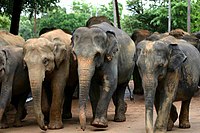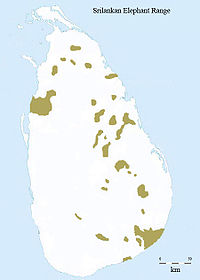|
Vikidia currently has 4,621 articles. Improve it! |
|
Join Vikidia: create your account now and improve it! |
Sri Lankan elephant
The Sri Lankan elephant (scientific name : Elephas maximus maximus) is an Asian elephant (scientific name : Elephas maximus). It is one of the three subspecies of the Asian elephant. The other two subspecies are the Indian elephant (scientific name : Elephas maximus indicus) and the Sumatran elephant (scientific name : Elephas maximus sumatranus). The Sri Lankan elephant is the largest of the three subspecies. They are about 11 ft tall, and can weigh up to 12,000 lb. They eat leaves, shrubs, grasses, and other plants.
These elephants are native to Sri Lanka, and once lived far and wide over the entire island. They now live in the dry zones in the north, east, and southeast. There are many national parks where tourists may see the elephant. These elephants were always useful animals in Sri Lanka. They carried timber and participated in public events like the Procession of Buddha's Tooth. They were hugely numerous in the past and aggressively hunted. In modern times, they are protected by law. Killing one carries the death penalty. They are an endangered species because farming and other human developments are destroying their living areas.
Description[edit | edit source]
Asian elephants are usually smaller than African elephants. Females are usually smaller than males. Females may live to about 46 years; it is uncertain how long the males live. The Asian elephant's highest body point is on the head. The tip of their trunk is used like a finger. Their back is curved upward or level. Their ears are smaller than those of the African elephant. Their feet have more "nails" than those of African elephants. They have five "nails" on each front foot, and four on each back foot.
Only 7% of Sri Lankan male elephants develop tusks. A tusk is a very long tooth that protrudes from the elephant's mouth. An elephant with huge tusks is called a "tusker". Females have short or no tusks. Sri Lankan elephants are the largest subspecies of the Asian elephant. Their shoulder height is between 6 and 11 ft. They weigh between 4,000 and 12,000 lb.
Like humans, apes, and dolphins, they have a large and well developed brain. They are very smart. Elephants have the largest brain of all land animals. Their memory is awesome. They can remember places, people, and events from long in the past. Their skin color is darker than that of the two other Asian subspecies. They may have large patches of skin color loss (depigmentation) on ears, face, trunk, and tummy.
Distribution[edit | edit source]
The Sri Lankan elephant was once widespread on the island of Sri Lanka. In modern times, they mostly live in the island's dry zones of the north, east, and southeast.
These are mainly dry deciduous woodland, scrub, grassland, and marshes. The elephant does not live in the island's wet zones. Some Sri Lankan elephants live in protected areas like national parks.
Behavior[edit | edit source]
Social lives[edit | edit source]
Like the two other subspecies of Asian elephants, Sri Lankan elephants live in groups of 6 to 15 individuals that are related by blood. The group is led by a matriarch. She may be the oldest and most experienced of the females in the group. Sometimes a group will join another group to become a clan. The clan may then join another group or clan to become a herd.
A mother and her babies have strong ties. Babies nurse for 2 to 5 years. All elephants in the group will help in different ways to raise and protect the babies. When males reach the age of sexual maturity, the matriarch and other members of the group will force them away. This is so these males will not mate with their relatives. The babies of such close unions will very likely be inferior babies. Some babies may even have birth defects. Young males often form bachelor groups. Males become more solitary as they grow older. Adult males join females only for mating. Males do not help in raising the babies.
Feeding[edit | edit source]
Sri Lankan elephants are both browsers and grazers. They walk along and eat, and sometimes they stand still and eat what they can reach around them. They eat shrubs, leaves, grasses, and vines. They sometimes raid farm gardens and eat crop plants. Baby and young elephants tend to feed mostly on different grasses.
The food the Sri Lankan elephant eats is scarce in mature forests. Farming opens and clears the land though, making ideal places for elephants to find food. Adult elephants eat 300-400 lb. of food per day.
Asian elephants have poor digestive systems. They use less than 50% of the food they eat. They must eat hundreds of pounds of food every day to support their huge size.
These elephants will eat for up to 16 hours a day to meet their need for food. They drink from 25 to 50 gallons of water every day.
The elephant produces huge amounts of manure. In the wild, this manure carries and spreads undigested seeds in the elephant's diet. The manure is a source of food for insects and birds.
Reproduction[edit | edit source]
Asian male elephants are called bulls. They reach sexual maturity around the age of 12. Between the age of 10 and 20, bulls enter an annual phase called "musth". This is a time when they become sexually aggressive. They will fight other males to mate with a female. Females are called cows. Once having successfully mated, a baby elephant called a calf develops in his mother's womb. He is born after an 18 to 22-month period. Twins are rare. At birth, the calf weighs about 220 lb. He nurses from his mother's breasts for up to three years. Once a cow gives birth, she usually does not breed again until the first calf is weaned. This results in a birth interval of 4 to 5 years. Cows remain with their herd, but mature bulls are chased away.
Humans and elephants[edit | edit source]
In the distant past, Sri Lankan elephants numbered in the hundreds of thousands. They lived in all zones of the island. They were aggressively hunted by Sri Lankans, other Asians, and Europeans.
In the 19th century, a British officer was said to have killed 1,500 elephants. Other British officers held similar records. Between 1829 and 1855 alone, more than 6,000 elephants were captured and killed.
In 2014, there was an estimated 4,000 elephants on Sri Lanka. The Sri Lankan elephant is protected under the Fauna and Flora Protection Ordinance of Sri Lanka (FFPO), and killing it carries the death penalty.
Sri Lankan elephants are important to the economic and cultural life of Sri Lanka. Some are working elephants and are used to carry timber. These elephants are losing their jobs because tractors are replacing them.
Elephants can be seen in protected areas and national parks. These elephants attract tourists. This trade improves the economy and the lives of Sri Lankans.
The elephant has always been held in great cultural esteem in Sri Lanka. Rajah, a Sri Lankan elephant with tusks that nearly touched the ground, was declared a national treasure in 1985.
Sri Lankan elephants participate in ceremonies, processions, and other public events. The Esala Perahera (the festival of Buddha's tooth) is held annually in Kandy, Sri Lanka. It is thought to date to the 3rd century BC. Elephants lead the procession, bearing the sacred tooth.
Endangered species[edit | edit source]
Sri Lankan elephants face the same threats to survival as other Asian elephant subspecies do. Elephant living areas in Sri Lanka are decreasing, and becoming fragmented because of forest clearing for human settlements and agriculture. This situation promotes conflicts between elephants and humans. These conflicts have led to the death of both humans and elephants, and the destruction of property. The problem is complicated by the elephant's taste for crops grown by humans such as sugar cane, bananas, and other fruits. In 1997, about 126 wild elephants were lost as a result of these conflicts. Conflict between government troops and the terrorist group, the Tamil Tigers in the northeastern region, has also put elephants at great risk.

|
Animals Portal — All articles about animals |

|
Endangered Species Portal — All articles about endangered species |









